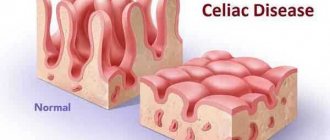Absorption of phosphorus from food
In the gastrointestinal tract, approximately 2/3 of the incoming phosphorus is absorbed from animal products. This is a fairly large share. Absorption from cereals and other plant foods is somewhat worse, because they contain phytic compounds that impair the absorption of a number of minerals.
Interestingly, if cereals or beans are pre-soaked, this makes the phosphorus they contain more accessible to the body. In the presence of large amounts of iron, calcium and magnesium, phosphorus absorption decreases.
Products containing phosphorus
Phosphorus is found in almost all products. But most of all it is found in meat, fish, seafood, poultry, eggs, and dairy products. Dry yeast contains a large amount of phosphorus. There are 1290 ml of phosphorus per 100 g of product. About the same amount is contained in bran and pumpkin seeds.
When compiling your diet, you need to choose the right products and take into account not only the phosphorus content in the products, but also calcium. The optimal ratio of calcium and phosphorus entering the body is 2:1. Violation of these proportions leads to a deficiency or excess of calcium or phosphorus in the body.
A good option would be to include beets, carrots, cabbage, hazelnuts, cottage cheese, beef liver, oatmeal, buckwheat, wheat porridge, walnuts, and beans in your daily diet.
- Cereals . A lot of phosphorus is contained in wheat, oatmeal, corn, and barley cereals. It is concentrated in the shell, so it is better to buy unprocessed for cooking. The leader among them is corn. A glass of cornmeal contains 850 mg of phosphorus;
- Broccoli . 100 g of cabbage contains 66 mg of useful microelements. In addition, it is rich in iron, calcium, potassium, zinc and, in addition, it is low in calories. When preparing it, the most important thing is not to subject it to long-term heat treatment;
- Nuts, seeds . The most useful are pine nuts, walnuts, and pistachios. Just 70 g of nuts is enough to replenish 40% of the required amount of phosphorus per day. Sunflower, sesame, chia, and pumpkin seeds are rich in phosphorus. So, 100 g of pumpkin seeds completely covers its daily requirement;
- Seafood and sea fish . The presence of seafood in the diet helps improve the functioning of the cardiovascular system. In addition to phosphorus, they are rich in iodine, vitamins, zinc, and valuable Omega-3 acids, so necessary for the normal functioning of the body;
- Dairy . The leaders in phosphorus content are cottage cheese, milk, yogurt;
- Poultry meat . Chicken and turkey meat are an excellent source of phosphorus. In addition, it contains a lot of protein, vitamin B, selenium;
- Legumes . White beans contain more phosphorus, red beans contain slightly less. They are especially valued for their high fiber content;
- Peanut paste . Peanut butter also contains this beneficial microelement. The most useful is the one without thickeners and sweeteners.
Biological role of phosphorus
Functions of phosphorus:
• Strengthens bones and teeth, as it participates in the mineral metabolism of dense tissues • Improves muscle function • Increases mental abilities, intellectual productivity, improves nervous activity • Participates in the processes of obtaining energy in the body, is part of the adenosine triphosphate molecule (the main “storage” of energy in the body human) and its derivatives • Necessary for the biosynthesis of amino acids, protein, DNA, RNA, the process of cell division, renewal of tissue structures, their restoration after damage • Regulates carbohydrate metabolism, blood sugar levels • Supports fat metabolism, plays an important role in maintaining normal weight • Improves the transmission of impulses in the nervous system • Important for the functioning of the parathyroid glands • Improves the effects of vitamin D, calcium • Regulates the acid-base balance of the body • Indispensable for blood health • Part of a huge number of enzymes, which makes it a participant in almost all vital processes.
Harm
A lack or excess of phosphorus can lead to the development of various diseases. Phosphorus deficiency can be caused in people by insufficient intake of phosphorus from food during fasting, alcohol abuse, or persistently elevated blood sugar.
Signs of hypophosphatemia:
- Chronic fatigue;
- Increased anxiety and irritability;
- Sudden weight fluctuations;
- Weakness;
- Joint pain.
Due to phosphorus deficiency, the immune system weakens and the body becomes more susceptible to various infectious diseases.
Excessive phosphorus levels are rare in healthy people. Hyperphosphatemia affects people with end-stage kidney disease and excess vitamin D. It is usually asymptomatic.
This disease can develop due to insufficient calcium absorption. Symptoms of hypocalcemia are manifested in increased excitability, the appearance of tremors, convulsions, sleep disturbances, tachycardia, and repeated vomiting.
Signs of phosphorus deficiency
If too small doses of phosphorus enter the body, the functions of the element are impaired. As a result, a person may experience a deterioration in general well-being, weakness, increased fatigue, paresthesia (unpleasant sensations) in different parts of the body, decreased mental productivity, decreased appetite, and mood disorders.
Immunity decreases, a person becomes more prone to various diseases. There is a predisposition to heart and liver diseases.
Bone Health – Why It's Important to Consider
We take care of the health of blood vessels and the heart, the condition of the skin, intestinal microflora, and devote a lot of time to muscle training. But we forget that the skeleton is the basis of the body. It is he who creates the support. Bones anchor muscles, protect internal organs, and retain calcium.
The human skeleton is a collection of bones of the human body, the passive part of the musculoskeletal system.
The adult human skeleton consists of 206 bones. Of these, 32-34 are unpaired, the rest are paired. 23 bones form the skull, 32-34 - the spinal column, 25 - the ribs and sternum, 64 - the skeleton of the upper extremities, 62 - the skeleton of the lower extremities.
Source Wikipedia
It is important to take steps to protect your bone health.
A number of factors influence their health:
- Floor;
- Age;
- Weight;
- Nutrition;
- The amount of calcium in the diet;
- Physical activity;
- The risk of developing osteoporosis is increased by alcohol abuse and smoking.
Bones become stronger up to 25 years of age, but after 30 they lose strength if a person leads a sedentary lifestyle and does not maintain the balance of such important elements as phosphorus, calcium and magnesium. During the entire skeletal growth phase, the body must receive sufficient amounts of calcium and vitamin D to build it up.
It is especially important to take care of bone health for women during menopause. During this period, bone density decreases and the risk of osteoporosis increases. Any awkward movement or fall can result in broken bones.
The following will help replenish your calcium, magnesium, phosphorus and vitamin D reserves:
- Dairy products;
- Animal protein;
- Eggs;
- Fish, seafood;
- Vegetables;
- Fruits;
- Whole grain.
Signs of excess phosphorus
Excessive amounts of phosphorus in the body can accumulate:
1. In people who exercise and consume large amounts of protein for muscle growth. If the diet is not prepared correctly, this can cause an excess of the mineral. 2. For those who often consume canned food, carbonated drinks and other factory products: they contain preservatives that include phosphorus. 3. In workers of industrial enterprises where people come into contact with phosphorus compounds.
The first two cases are mild. The latter is more dangerous, since some phosphorus compounds can have obvious toxic effects on the body. There are usually no specific symptoms with a slight excess of the mineral. A person simply experiences a general deterioration in his condition, he becomes predisposed to diseases of the kidneys, liver, heart, gastrointestinal tract, leaching of calcium from bones with a tendency to fractures. If a person is poisoned by phosphorus compounds that are dangerous or enter his body in a large dose, then he will develop symptoms of poisoning that require immediate medical attention.
Speaking about excess phosphorus in the body, I would like to dwell briefly on point 2 of the above list. To avoid an excess of the mineral, or rather, an “overdose” of phosphorus-based substances added to food, you should limit the following foods in your diet:
• Ham, sausages, sausages (phosphoric acid salts are added to them, which maintain the stability of products and extend their shelf life) • Carbonated drinks (phosphoric acid is added to them, it gives them “sourness”) • Pastries, cakes, desserts (also contain phosphoric acid) • “3 in 1” coffee, chocolate drinks in powder form, dry cream - phosphates prevent the formation of lumps, maintain the crumbly state of products • Condensed milk (phosphates prevent its sugaring) • Processed cheese (maintains softness) • Margarine (prevents airing , increase shelf life) • Canned pineapples, peaches and other fruits and vegetables (preservatives with phosphorus prevent them from “falling apart”, keep them intact) • Refined sugar (provide white color).
What to eat?
The main sources of phosphorus are animal products: meat and milk. If a person strives to maintain an optimal balance of calcium in the body, phosphorus is usually enough for him. The highest levels of phosphorus are found in chicken, beef, fish, dairy products and eggs. For every gram of animal protein there is 12 to 15 mg of phosphorus. There is a lot of phosphorus in nuts, cereals and beans, but it is absorbed worse from plant foods than from animal foods, since it is mainly contained in the chemical compound phytin, which the human body does not absorb. Keep this in mind if you decide to give up animal products. Fruits and vegetables contain very little phosphorus.
How it is absorbed and what it interacts with
P is best absorbed together with the macronutrient Calcium (Ca). The optimal balance of metalloids is characteristic of hard cheese made from cow's milk and hazelnuts. But the correct ratio is successfully established with the predominance of other foods in the diet, since the exchange is coordinated by parathyroid hormones. Vitamins ADF also affect the absorption of phosphorus; you also need to remember about potassium, iron and magnesium, so for the body to function properly, you need food that contains various components.
Phosphorus is hindered by an excess of chemical elements such as barium, aluminum, and calcium. They quickly form compounds that are not able to take part in metabolic processes.
Age and sex differences in dosage
A healthy adult man who does not experience strenuous physical activity should consume 1000-1500 mg of the macronutrient daily (normal blood concentration 0.81-1.40 mmol/l). For a woman - 200 mg less. During pregnancy and lactation - 3000-3800 mg.
If there are persistent dental problems - vulnerability to caries, periodontal disease - it is necessary to increase the proportion of phosphorus-containing products in the menu. Situations where osteoporosis is diagnosed, as well as with increased activity (physical labor, nervous work at a high pace) deserve special attention - under such circumstances, the daily phosphorus intake for a person should be increased. Its correction is carried out only with the participation of a doctor, often with the help of medications and vitamin-mineral complexes.
How much do children need:
- newborns - 120 mg;
- up to six months - 400 mg;
- up to one year - 500 mg;
- up to 3 years - 800 mg;
- up to 8 years - 1000 mg;
- up to 18 - 1300 mg.
The best way to provide the optimal amount of essential nutrients for your baby is through breastfeeding. Breast milk contains ideally balanced macro- and microelements; its composition changes as the baby grows. That is why WHO recommends continuing breastfeeding for at least 2 years. If the daily requirement for phosphorus is not met, the child may suffer from frequent bleeding, lethargy, and become bored while learning. Intellectual abilities are reduced, normal personality development is hampered. The risk of osteoporosis and other bone diseases also increases.
Story
Phosphorus
discovered by the Hamburg alchemist Hennig Brand in 1669.
Like other alchemists, Brand tried to find the philosopher's stone, but received a luminous substance. Brand focused on experiments with human urine because he believed that, being golden in color, it might contain gold or something needed to mine it. His original method was to first let the urine sit for several days until the unpleasant odor disappeared, and then boil it until it became sticky. By heating this paste to high temperatures and causing bubbles to appear, he hoped that when they condensed, they would contain gold. After several hours of intense boiling, grains of a white wax-like substance were obtained, which burned very brightly and also flickered in the dark. Brand named this substance phosphorus mirabilis
(Latin for “miraculous bearer of light”). Brand's discovery of phosphorus was the first discovery of a new element since antiquity.
Joseph Wright's painting The Alchemist Discovering Phosphorus (1771), supposedly describing Hennig Brand's discovery of phosphorus.
Somewhat later, phosphorus was obtained by another German chemist, Johann Kunkel.
Regardless of Brand and Kunkel, phosphorus was obtained by R. Boyle, who described it in the article “Method of preparing phosphorus from human urine,” dated October 14, 1680 and published in 1693.
A more improved method for producing phosphorus was published in 1743 by Andreas Marggraff.
There is evidence that Arab alchemists were able to obtain phosphorus in the 12th century.
Lavoisier proved that phosphorus is a simple substance.
An amorphous allotropic modification of phosphorus, red phosphorus Pn, was isolated by heating white phosphorus without air access by A. Schrötter in the middle of the 19th century.
Harm from phosphates used in the food industry
In the food industry, phosphates are used in products for the following purposes:
- As an acidulant in carbonated drinks
- Phosphates retain water in food, increasing its weight and volume, preventing the formation of broth-fat edema, and preventing drying out during storage. Mainly used in fish, poultry and meat products (boiled, boiled-smoked sausages, sausages)
- Phosphates are added to condensed milk to help prevent the product from crystallizing.
- They are added to dry bulk products, preventing caking and the formation of lumps in the powder. It is used in dry cream, milk powder, powders containing dry cocoa.
- Added to processed cheeses, providing their consistency
- Used for temperature processing of milk and dairy products
- When making ice cream and other products from dry mixes, phosphates increase the rate of their dissolution during production.
- Used to increase the shelf life of butter and margarine
The following symbols can be found on the labels:
- E 340 - potassium phosphates
- E 338 - orthophosphoric acid (or simply phosphoric)
- E 343 - magnesium phosphates
- E 341 - calcium phosphates
- E 342 - ammonium phosphates
Consequences of the harmful effects of phosphates:
- Excessive intake of phosphates into the human body disrupts the balance in tissues between phosphorus and calcium, which leads to disruption of the structure of bone tissue and disruption of metabolic processes in the human body. Excess phosphorus leads to bone diseases in the form of osteoporosis.
- Excess phosphorus leads to an increased risk of cardiovascular diseases and an increased risk of heart attacks. This occurs due to the deposition of calcium on the inner walls of blood vessels, which leads to their blockage. All this occurs due to a disturbance in the calcium-phosphorus balance.
Total information
Location on the periodic table D.I. Mendeleev: in the old version - III period, III row, V group, in the new version of the table - 15 group, 3rd period.
- Atomic number – 15
- Atomic mass – 30.973762
- Electronic configuration – [Ne] 3s2 3p3
- Melting point (°C) – 44.15
- Boiling point (°C) – 279.85
- CAS: 7723-14-0
Physicochemical characteristics. Phosphorus is known in many modifications - white, red, yellow, black, metallic, etc., which are also called allotropic. Physical and chemical properties directly depend on its form, especially its chemical activity.
White phosphorus is a chemically active substance that is white with a slight yellowish or greenish tint, similar to paraffin, and is easily deformed with little physical effort. Poorly soluble in water, upon contact with oxygen and light it begins to glow pale green. A slight exposure to temperature can lead to spontaneous combustion of the substance. Very poisonous - ingestion of just 0.05-0.15 g of the substance can be fatal. Upon contact with skin, it is also capable of self-ignition, after which it leaves severe burns.
Red phosphorus is a more heat-resistant form of the element, which is obtained from its white form. Painted in red, purple colors with a metallic sheen. It does not dissolve in water, does not glow in the dark, and can spontaneously ignite upon impact or friction. The toxicity is thousands of times less compared to white. It is used in the manufacture of matchboxes - it is part of the rubbing surface.
Daily requirement
The daily requirement of phosphorus depends on age, body weight, work intensity and well-being of the human body. Therefore, on average, the norms of this substance should be:
- Infants up to five months: 110 milligrams;
- Six-month-olds and children under one year of age: 280 milligrams;
- Children from one to three years: 480 milligrams;
- Children four to nine years old: 530 milligrams;
- Ten to eighteen years: 1150 milligrams;
- People over eighteen: 1000 milligrams;
- Pregnant and breastfeeding women: 1200 milligrams;
- People with heavy loads: from 1400 to 2000 milligrams.
Lack of phosphorus in the human body
Causes of phosphorus deficiency:
- phosphorus metabolism disorders
- unsatisfactory amount of macronutrient intake into the body (low protein intake)
- excessive levels of magnesium, calcium, barium, aluminum compounds in the body
- excessive consumption of synthetic drinks (carbonated drinks, etc.)
- long-term chronic illnesses
- poisoning, drug addiction, alcoholism
- pathologies of the thyroid gland, parathyroid glands
- kidney disease
- feeding an infant with artificial formula
Symptoms of phosphorus deficiency:
- general weakness, loss of appetite, exhaustion
- muscle and bone pain
- Resistance to infections and colds decreases;
- liver protein synthesis decreases
- dystrophic changes in the myocardium, hemorrhagic rashes on the mucous membranes and skin appear
- in some cases – mental disorders
- rickets, periodontal disease
When there is more phosphorus than calcium in the body, the human body will use the calcium that is stored in the bones.
Interaction of phosphorus with other elements and drugs
Phosphorus in its pure form is a chemically unstable element, so it easily interacts with other substances. In nature and in our body, phosphorus is found mainly in the form of chemical compounds with other substances.
The content of phosphorus and its compounds in our body can be influenced by various external factors and other substances coming from food.
Let's consider substances that can have a significant effect on the phosphorus content in the human body:
- Alcohol can leach phosphorus from bones and reduce overall phosphorus levels in the body.
- Antacids (reduce stomach acid) containing aluminum, calcium or magnesium can bind phosphate in the intestines. When used long-term, these drugs can lead to a decrease in phosphorus levels in the human body (hypophosphatemia).
- Anticonvulsants may lower phosphorus levels and increase levels of alkaline phosphatase, an enzyme that helps remove phosphate from the body.
- Bile acid drugs lower blood cholesterol levels. They may reduce the oral absorption of phosphate from food or supplements. Oral phosphate supplements should be taken at least 1 hour before or 4 hours after these medications.
- Corticosteroids, including increasing urinary phosphorus levels
- Potassium or drugs that are high in potassium can cause too much potassium in the blood (hyperkalemia). Hyperkalemia can cause dangerous heart rhythm problems (arrhythmias). Salt substitutes that also contain high levels of potassium and phosphorus may cause low levels when used in the long term.
- ACE inhibitors (blood pressure medicine). These are drugs called angiotensin-converting enzyme (ACE) used to treat high blood pressure that can lower phosphorus levels.
- Other medications can also reduce phosphorus levels. These drugs include cyclosporine (used to suppress the immune system), cardiac glycosides (digoxin or Lanoxin), heparins (blood thinners), and nonsteroidal anti-inflammatory drugs (such as ibuprofen).









